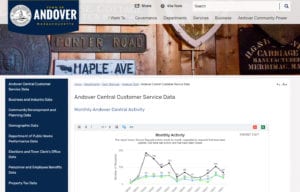Who is a member?
Our members are the local governments of Massachusetts and their elected and appointed leadership.

Residents can review town customer-service statistics and a range of other information on the new Andover Data portal.
Hoping to bolster transparency around municipal operations and provide one-stop information for residents, Andover recently launched an online data portal detailing everything from historical property-tax analysis and demographic data to response times for potholes and beaver complaints.
In late April, the town unveiled Andover Data, which provides statistics on various aspects of the town’s work, including its customer-service response rates, business and industry activity, community development and planning projects, public works performance, demographics, elections and town clerk data, and streetlight locations.
The town will update the data and add topics as it receives new information, said Assistant Town Manager Patrick Lawlor. He added that the Andover Data portal provides a digital complement to Andover’s plans to include a customer-service center in its renovation of town offices.
“This model has carried through to every element of government here, from our physical interactions to our digital interactions,” Lawlor said. “Ultimately, our goal is to have a stronger and better relationship with our community.”
Lawlor said the data portal grew out of its 311 phone service and Andover Central, an online customer-service hub, which the town launched a year-and-a-half ago. Both services allow residents to make service requests. The popularity of Andover Central, which allows residents to track requests, encouraged officials to broaden transparency around town operations, he said.
According to Lawlor, the town wanted to display the customer-service data it was generating from the 311 system, as well as other useful information for residents. For instance, Andover was publishing interesting data in its annual report, but couldn’t be sure how many people actually read the 100 page-plus publication.
“Part of this, too, was this sort of inherent belief that we need to do a better job of telling our story,” Lawlor said. “The actual output of the town services is pretty remarkable, so that’s a story worth telling.”
Thanks to the portal, residents can learn that the town resurfaced 14.5 miles of road and installed more than 3,500 feet of curbing in 2019, Lawlor said. They can also learn how their property tax bills have changed over time, and how theirs compare to tax bills in other communities. Lawlor said he researched old Finance Committee reports to help assemble historical tax data.
“There are a lot of things that we talk about a lot, and that don’t have a lot of context, and I think this is a tool to provide that context,” Lawlor said.
The town soon hopes to include a real-time, energy-use tracker for public buildings; a tracker showing which streets have been plowed or sanded during winter storms; and information detailing the efficiencies created through fiscal management and technology improvements.
The town also hopes to work with high school students, Lawlor said, and use data contributed by residents. He envisions “a cross-pollination of everybody in town” to keep the project moving forward.
The data portal took six to seven months to materialize, Lawlor said. The project didn’t cost much money, as the work was largely completed by himself, staff in the town manager’s office, and a small interdepartmental team. Going forward, he said, the town will expect every department to contribute relevant data.
“It’s going to be something that we’re going to really engage every department and every employee in town to look at and say, ‘What’s some information that we can display that will not only build our trust with the community, but it will help us work better, too?’” Lawlor said.